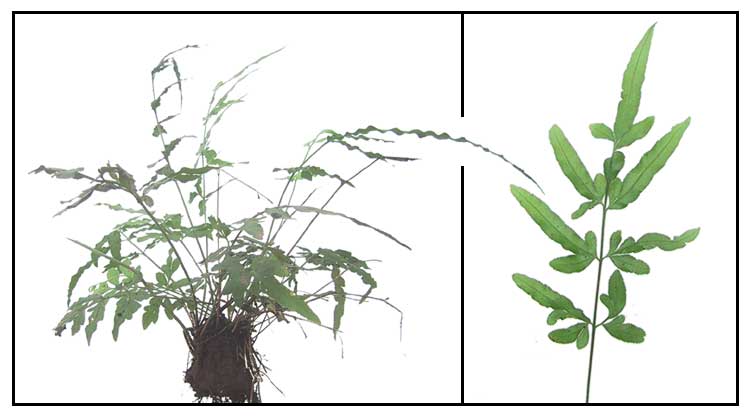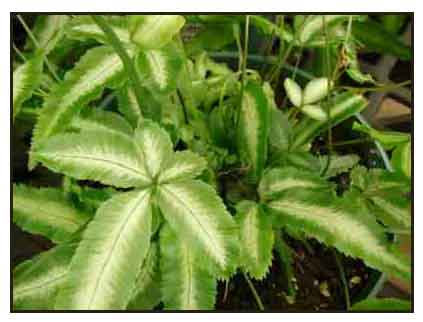|  Gen info Gen info
- The genus Pteris has
about more than 650 species.
-
Not uncommon in the confusing sharing of Philippine common names, a compilation lists Pakong-parang with
Pteris mutilata. Quisumbing's compilation lists it under Pteris ensiformis and Pteris crenata. Although the botanical description shares significant
similarities, the folkloric uses differ.
- Pteris ensiformis is a plant species in the genus Pteris in the family Pteridaceae.
- Etymology: The genus Pteris derives from the Greek word "pteruc" meaning "fern". The species epithet ensiformis refers to the "sword-shaped" leaves.
 Botany Botany
Pakong-parang is a small terrestrial fern, with creeping rhizomes,
sparingly clothed with adpressed scales. Stipe (fern "stem") of fertile fronds are 5 to 10 centimeters
long; those of the sterile fronds longer, 10 to 30 centimeters long; pale, glabrous
and fascicled (growing in dense tufts). Fronds are thin and glabrous, 10
to 30 centimeters long, with very few pinnae; sterile fronds are shortest, 5 to 15
centimeters broad, with the lowest or all lateral pinnae pinnate, with few sharply
serrate, oblong lateral pinnules, 7 to 10 millimeters wide; the fertile fronds
with pinnae correspondingly forked instead of pinnate, the segments
longer, linear and 4 to 8 milimeters wide. Sori are on the lower surface of the leaflets, along the margins
in a dense uninterrupted row which does not extend to the apex. Sori
protected by a reflexed membranaceous projection of the margin.
Distribution
- Native to the Philippines.
-
In open woods, at low and medium altitudes, throughout the Philippines.
- Also native to Andaman Is., Assam, Bangladesh, Bismarck Archipelago, Borneo, Cambodia, China, Fiji, Hainan, Himalaya, Japan, Lesser Sunda Is., Malaya, Maluku, Marianas, Myanmar, Nansei-shoto, Nepal, New Caledonia, New Guinea, Nicobar Is., Samoa, Solomon Is., Sri Lanka, Sulawesi, Taiwan, Thailand, Tonga, Vanuatu, Vietnam, Wallis-Futuna Is. (12)
 Constituents Constituents
- Study of ethyl acetate extract isolated three new compounds: 2R,3R-pterosin L 3-O-β-D-glucopyranoside (1), β-D- xylopyranosyl(1→2)-7-O-benzoyl-β-D-glucopyranoside (2) and 4-O-benzoyl-β-D-xylo- pyranosyl(1→2)-7-O-benzoyl-β-D-glucopyranoside (3), together with nine known compounds: 5-[2-hydroxyethylidene]-2(5H)-furanone (4), pterosin B (5), β-D-glucopyranosyl benzoic acid ester (6), benzoic acid (7), 5-O-coumaroylquinic acid (8), coumaric acid (9), cyclolaudenol (10), β-sitosterol-3-O-β-D-glucoside (11), and β-D-sitosterol (12). (see study below) (9)
- Study of whole plants yielded two new pterosin sesquiterpenes, (2S)-13-hydroxypterosin A (1) and (2S,3S)-12-hydroxypterosin Q (2), together with six known compounds. (see study below) (13)
- In a study of heavy metal concentrations of Pb, Ni, and Co in soil (S) and leaves (L) of some ferns, Pteris ensiformis yielded: Pb 20.635 ± 2.42 mg/kg (S) 30.370 ± 9.90 mg/kg (L); Ni 2.464 ± 1.65
mg/kg (S) 8.550 ± 1.86 mg/kg (L); Co 1.135 ± 0.44 mg/kg (S), not detected in leaves. (15)
- Phytochemical investigation of P. ensiformis isolated a new-ent-kaurane diterpenoid, ent-kaurane-6ß,16α-diol-3-one (1), along with five known diterpenoids (206), and three known sesquiterpenes (7-9). (see study below) (16)
- Study of aqueous extract by spectroscopic analysis yielded three new compounds, kaempferol 3-O-α-l-rhamnopyranoside-7-O-[α-d-apiofuranosyl-(1-2)-β-d-glucopyranoside] (1), 7-O-caffeoylhydroxymaltol 3-O-β-d-glucopyranoside (3) and hispidin 4-O-β-d-glucopyranoside (4), together with five known compounds, kaempferol 3-O-α-l-rhamnopyranosid-7-O-β-d-glucopyranoside (2), caffeic acid (5), 5-O-caffeoylquinic acid (6), 3,5-di-O-caffeoylquinic acid (7) and 4,5-di-O-caffeoylquinic acid (8). (see study below) (2)
- Study of ethyl acetate extract of Pteris ensiformis yielded three new compounds: 2R,3R-pterosin L 3-O-β-D-glucopyranoside (1), β-D- xylopyranosyl(1→2)-7-O-benzoyl-β-D-glucopyranoside (2) and 4-O-benzoyl-β-D-xylo- pyranosyl(1→2)-7-O-benzoyl-β-D-glucopyranoside (3), together with nine known compounds. (see study below) (3)
- Study of Pteris ensiformis yielded two new dihydrochalcone enantiomers (+)-1 and (-)1, along with eight known compounds (3-10). (see study below) (17)
- Phytochemical study isolated 11 compounds, including three sesquiterpenoids (1-3), one alkaloid (5), one amino acid (6), one flavonoid (7), four phenolic acids (4, 8, 9 and 10), and one coumarin (11).
(23)
Properties
- Sweetish-tasting.
- Antipyretic, antirheumatic, antidysenteric.
- Studies have shown immunomodulatory, anti-inflammatory, antioxidant, antiatherogenesis, cytotoxic, antitubercular, antiproliferative properties.
Part
utilized
Leaves, roots.
Uses
Edibility
· Young fronds are eaten steamed; used as flavoring.
· In Taiwan, an ingredient in most of the traditional beverage formulas.
Folkloric
· In Pahang, juice of young fronds used as astringent for cleansing unhealthy tongues of children.
· Root juice from the rhizome is applied to glandular swellings of the neck.
· Decoction of fresh fronds drunk by dysenteric patients.
· Used for bacillary dysentery,
enteritis, fever, malaria, swelling and painful throat: 30 to 60 gms
dried material in decoction.
· Used for urinary tract infection, leucorrhea: 30 to 60 gms dried material
in decoction.
· Used as poultice in mumps, measles, and eczema.
· Used to control menstruation in Bougainvelle.
· In the Kurtatchi area (N.W. Bougainville) of Papua New Guinea, root is chewed with betel, some are swallowed and the rest rubbed on the abdomen to shorten the duration of menstruation or to prevent its occurrence for two or three months. (19)
· In New Guinea, fronds applied to
boils, ulcers and arrow wounds; also used to control menstruation.
· A decoction of Eclipta prostrata and Pteris ensiformis used
for hemorrhoidal bleeding, dysentery and enteritis.
· In Vanuatu, for dysmenorrhea, a handful of leaf fronds are rubbed over the abdominal area. (10)
Studies
• Immunomodulatory:
Study showed sword brake fern attenuates inflammatory mediator synthesis of activated macrophages partially through a NF-kB-dependent pathway. (1)
• Phenolic Antioxidants:
Study showed SBF exhibited strong antioxidant activity, attributed to the phenolic compounds, especially derivatives of caffeic acid, hispidin and kaempferol. (see constituents above) (2)
• Benzoyl Glucosides and Cytotoxic Pterosin Sesquiterpenes / HL 60 (Human Leukemia) Cells:
Study yielded 3 new compounds together with nine known compounds. Compound 1 (2R,3R-pterosin L 3-O-β-D-glucopyranoside) and pterosin B (5) showed cytotoxicity against HL 60 cells (human leukemia) with IC50 values of 3.7 and 8.7 µg/mL, respectively. (see constituents above) (3)
• Anti-Atherogenesis / Anti-Inflammatory / Antioxidant: Study
showed the hot water extract of SBF exhibited potential anti-inflammatory
activities in murine RAW264.7 macrophages. also, SBF and its active component, a pteridoside, were scavengers of DPPH, hydroxyl radicals and superoxide. Results also showed LDL oxidation was suppressed by SBF and suggests further studies to defines its exact roles of the natural components on atherogenesis. (7)
• Antioxidant / Anti-Atherosclerosis: Study of sword brake fern aqueous extract isolated 2 new compounds: 7-O-caffeoylhydroxymaltol 3-O-B-D- glucopyranoside and hispidin 4-O-β-d-glucopyranoside [6-(3,4-dihydroxystyryl)-4-O-β-d-glucopyranoside-2-pyrone] The aqueous extract and two compounds strongly inhibited Cu2+-mediated LDL oxidation. Results showed it may prevent atherosclerosis through inhibition of both LDL oxidation and ROS production. (9)
• New Benzoyl Glucosides / Pterosin / Cytotoxicity Against HL 60 Cells: Study of ethyl acetate extract yielded three new benzoyl glucosides together with nine known compounds. Compound 1 and pterosin B (compound 5) showed cytotoxicity against HL 60 cells (human leukemia) with IC50 of 3.7 and 8.7 µg/mL, respectively. (see constituents above) (12)
• New Pterosin Sesquiterpenes / Antitubercular: Study of whole plants yielded two new pterosin sesquiterpenes, (2S)-13-hydroxypterosin A (1) and (2S,3S)-12-hydroxypterosin Q (2), together with six known compounds. Compound 2 exhibited antitubercular activity (MIC 6.25 µg/ml) against Mycobacterium tuberculosis H37 Rv in vitro. (13)
• Element Concentration: In a study on element concentrations of 19 terrestrial fern species, pteris ensiformis showed the highest concentrations of Mg, Na, and Zn. (14)
• Cytotoxic Diterpenes: Phytochemical investigation of P. ensiformis isolated a new-ent-kaurane diterpenoid, ent-kaurane-6ß,16α-diol-3-one (1), along with five known diterpenoids (206), and three known sesquiterpenes (7-9). The ethanol extract and isolated compounds (1-9) were evaluated for their antitumor activity against three cancer cell lines. (16)
• Dihydrochalcones / Diterpenoids / Inhibition of LPS-Induced NO Production / Cytotoxicity: Study of Pteris ensiformis yielded two new dihydrochalcone enantiomers (+)-1 and (-)1, along with eight known compounds (3-10). Compounds (+)-1, (-)-1, 8, 9, and 10 exhibited inhibitory assay of NO production in mouse macrophages stimulated by LPS, with IC50 values of 2.0, 2.5, 8.0, 9.5, and 5.6 µM, respectively. Compound 10 (ent-11α-hydroxy-15-oxokaur-16-en-19-oic acid) showed moderate cytotoxicity against HCF-116, HepG2, and BCG-823 cell lines with IC50s of 3.0, 10.5, and 6.3 µM, respectively. (17)
• Alternative Polyunsaturated Fatty Acid Source: Study screened three-three samples for high contents of PUFAs using gas chromatography for alternative PUFA production. Results showed sword brake fern (Pteris ensiformis) produced the highest content of PUFAs of 28.13 mg/g dry cell weight, which included 4.94 mg/g linoleic acid, 4.50 mg/g arachidonic acid, and 18.70 mg/g α-linolenic acid. Results suggest Pteris ensiformis is a potential alternative PUFA source for commercial production. (18)
• Anti-Tubercular: Study of EtOAc-soluble fraction of whole plant yielded a new pterosin, along with 5 known compounds. Among the isolated compounds, (2S,3S)-13-hydropterosin T exhibited antitubercular activities (MIC 6.25 µg/ml) against Mycobacterium tuberculosis H37Rv in vitro. (20)
• Enrichment of Total Flavonoids / Antioxidant / Antiproliferative / Resin Adsorption: Study reports on an efficient and economical method for enrichment of total flavonoids from Pteris ensiformis using NKA-II resin as adsorbent. The product had a 6.63-fold higher total flavonoids content than crude extracts, with a recovery yield of 80.65%. Higher antiproliferative activity of the flavonoids-enriched extracts was found against MCF-7 and HepG-2 cell lines as compared to crude extracts. The method has potential for large-scale enrichment of total flavonoids from P. ensiformis in the food and pharmaceutical industries. (22)
Availability
- Wild-crafted.
- Plants in the cybermarket. |


![]()

